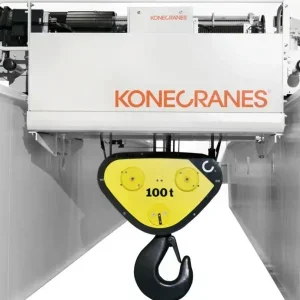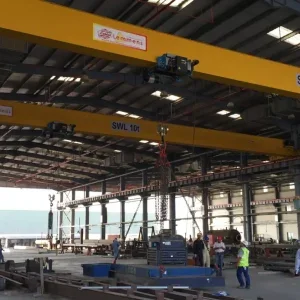Technological developments have continued apace among remote control manufacturers and the lifting equipment sector has benefited as a consequence. Much of the new development, of course, is spurred on by customer demands and these, said Controls, range from an increased focus on safety for the worker, workload, and the work environment, to a desire for greater cost efficiency, increased reliability and the ability to reduce labour costs.
Laird also points to requests for more lightweight, ergonomic designs that still retain a "substantial" feel. Greater reliability, including in connectivity, location tracking and actionable data delivery are also on customers’ lists of requirements, as are added functionality to enable more complex solutions.
Laird says part of its response to customer demands has been to offer predictive analytics and intelligent data solutions that provide meaningful, actionable data, giving an audit trail for what happened from the machine’s point of view.
"We put safety first all the time and offer leading safety controls like RF Range Control and e-Stop solutions," said David Stagg, product manager at Lair Controls North America. "We are leading the way with simultaneous control solutions too."
"We are seeing attitudes towards leveraging wireless e-Stop solutions changing, meaning operations are more open to the possibilities of wireless and its enhanced security and integrity of the RF transmission protocol in industrial applications," said Rick Morse, senior vicepresident and general manager at Lair Controls.
Stagg adds that wireless solutions, such as e-Stop, bring speed of response to the user in critical situation, saving valuable seconds, and offer a "best position vantage point" for operators.
"Our solutions are engineered with user ergonomics as a top priority, so that the physical process of moving the machine is intuitive. And with an in-use lifespan of more than 20 years, our solutions are built to last."
In terms of advancements in technology standards, Laird also highlighted EN ISO 13849-1, which addresses the programmable electronic safety devices that are increasingly being used.
"The standard also provides a quantitative approach to risk assessment and safety validation," said Morse. "This ensures that safety is not solely a matter of component reliability, but also relies on common sense safety principles such as redundancy, diversity and fail-safe behavior. Ikusi agrees that customer demands are becoming more rigorous day by day. "They ask for customised, secure and detailed solutions that are easily installed, used and maintained," said Pedro Esnaola, Ikusi remote control director.
He says that Ikusi has responded to demands for accurate feedback by adapting the remote control system to the features included in the machinery, enabling it to "understand" and process the information prior to feeding it back to the operator.
"The TFT colour displays of the I-Kontrol range console box transmitters enable this feedback, which can be visualized on PLC," said Esnaola.
The text format information is shown in 4×20 characters, with or without LEDs, or in 2×10 characters with LEDs. The new display also offers the possibility to present the information graphically in the form of icons.
Other key customer demands have been the need to avoid frequency collisions – solved by Ikusi’s AFA (automatic frequency agility) system, which allows the localization of available frequencies or better quality ones without any user intervention – and ease of configuration and maintenance, no matter where in the world the unit is located.
"Manufacturers with high export rates are obliged to offer a wide range of tools and solutions," said Esnaola. "When configuring a system the worldwide compatible multiband radio enables our products to be operational in every geographic areas, regardless of the working channels of each country."
He added that the external EEPROM, a removable memory card, allows quick and easy restoration of service with a spare unit in the case of transmitter or receiver failures. And a recently developed Troubleshooting mini-site is providing customers with more autonomy to diagnose and solve any system problems. HBC-radiomatic GmbH has also gone down the route of colour displays to satisfy growing demand for customization and for readily accessible review data.
"The new HBC micron 7 radio transmitter comes equipped with an innovative, configurable colour display," said Alexander Hemming, head of product management. "The operator can access various crane and machine data such as load weight and hook height during operation and the clear and organized display of fault messages and warnings helps the operator react quickly, which provides additional safety." The information on the displays is available in text or graphic form and operators are able to navigate through the screens via the newly developed radiomatic yuCON mini joystick.
Other key developments, said Hemming, are radiomatic photon – a video camera, which can be mounted on a crane or other suitable location and which supplies colour camera footage on the radio control display in real time – and radiomatic report, which allows the operating company to protect its machinery from unauthorized use.
This latter development, said Hemming, includes user identification via a merlin transmitter user card (TUC), which is held next to the transmitter to turn it on. Of course, as well as responding to customer demands, manufacturers are working with them to develop new solutions.
Ikusi points to its development of Twin Synchro functionality by way of example. The system was born out of collaboration with crane manufacturer GH and involved working alongside the latter’s technical office and production team.
"Twin Synchro functionality allows cranes to be synchronized from a single control station, synchronizing their movement through the receivers of the remote controls," said Esnaola. "This application improves the traditional way of performing these types of manoeuvres, which used to require a redundant system in addition to the remote control. Ikusi’s system for synchronizing cranes in tandem uses a single communication channel for transmitting commands to both cranes."
The potential for remote control technology is enormous, said Morse of Laird Controls, whose solutions are currently being used in more than 7,000 industrial environments, from aerospace, satellite and space station manufacture to rail yards and solar energy farms.
"Really, remote control technology offers solutions for any industry that needs to keep worker and workloads safe while moving large and/or dangerous loads," said Morse. "Think harsh environments where machinery is moving all the time, where productivity improvements are money gained, where reducing the toll on the worker allows for easier management of the machinery and the task in hand. It’s much easier to manage the operator control unit than it is the equipment itself!" Laird predicts that customers will continue to look for improvements in both the quality and cost efficiency of their operations and that increased use of predictive analytics tools will allow for better control and monitoring of maintenance and safety related incidents. Safety controls such as e-Stop and RF range control will also provide "zone control", said the company.
HBC agrees that operator safety, comfort and efficiency will remain the main drivers of development.
"Developments will be driven by innovations in machine and crane technology such as the introduction of new interfaces with even better performance," said Hemming. "At the same time, developments in other industry branches will be transferred and adapted by the radio control branch," he added. "An excellent example of this is our innovative operating concept, radiomatic pilot. This enables the safe and intuitive crane and machine control by simple hand movements, thus providing even more safety and operating comfort."
Ikusi also believes that reliability, safety, security and productivity will continue to be enhanced and that remote control devices will be incorporated in the machinery controlling logic.
"The remote control device’s added value lies in the management of this information, which can be useful for preventing breakdowns or controlling the use of machines," said Esnaola. Ikusi also makes the point that, as industry is developing more automated manufacturing processes, so its environment is moving in the same direction.
"In our opinion the software and applications development will become more sophisticated while, at the same time, the use of the devices will be much simpler and intuitive," said Esnaola. "In this respect manufacturers have to face a great challenge – how to introduce more complex and complete functionalities in a clear and operational way."
Elsehwhere, With the new DRC mini joystick hand-held transmitter, cranes can be ergonomically controlled with one hand using joysticks with a very compact control system.
Until now, operators had a choice of two systems for the radio control of cranes. They could either control the crane via a compact unit that had pushbuttons or via a large control unit similar to a panel fitted with joysticks.
They can now also benefit from the advantages of a joystick – convenient and ergonomic control of combined motions – with a very compact control unit. Terex Material Handling has launched a newly developed component from its new D3 generation of radio controls: the DRC mini joystick (DRC-MJ).
The housing of the new control unit is the same as the one used for the DRC DC hand-held transmitter. It is ideally suited for operation with one hand and was developed specifically for operation under arduous conditions.
The impact-resistant housing material has a smooth surface and is resilient to mechanical loads. Rubber-coated end caps make the control unit more tolerant of rough handling. The rechargeable batteries can be used for uninterrupted operation without the need to be recharged for five days.
Instead of the keypad panel, the development engineers have integrated two mini joysticks and four buttons into the housing. The lifting and lowering motions of a rope hoist can be carefully controlled using the top one of the two joysticks.
The joystick beneath it can be used for the variable control of two motion axes, i.e. two crane and travel functions. Simultaneous motions can also be controlled with just one hand, i.e. diagonal long and cross-travel motions, which is not only more convenient, but also accelerates the flow of material.
The maximum speed of the lifting and travel motions can be limited at the press of a button. The speed limit can be set to 30, 50 or 70% of the maximum speed for each motion axis. When the speed limit function is activated, the maximum deflection of the mini joysticks is used for the reduced maximum speed.
Elsewhere, Tele Radio has enjoyed ongoing success, and started the year by updating its Panther industrial remote control system with a PL d rated robust transmitter. The new Panther PN-T19-2 transmitter from is compatible with all existing receivers in the Panther product family and was initially developed to meet the specific requirements of crane applications, but fits "perfectly" in a vast array of situations, said the manufacturer.
The product is easy to hold and the robust housing makes it insensitive to shock. It also offers a wide range of programming options and meets the demands for safety classification PL d category 3.






